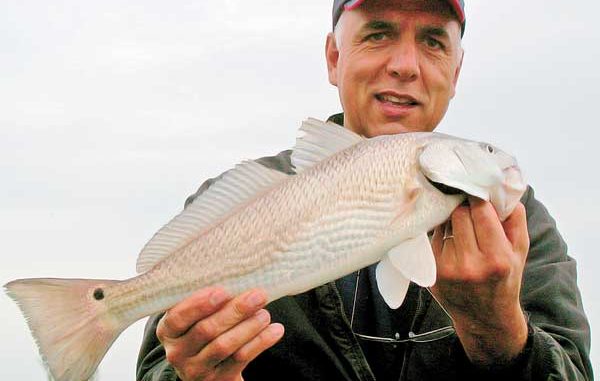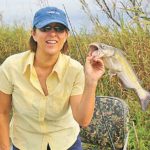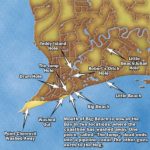
Conditions are less than ideal, but if you’re not too picky, you can have a blast in the morning and a feast in the evening.
There’s something to be said about slumming, and when it comes to springtime fishing in the narrow bayous that run into Atchafalaya Bay, you just might discover that one man’s trash is another’s treasure. Each spring, when the Atchafalaya River rises, a significant portion of that water flows down the Calumet Spillway making its way into the surrounding bayous of this central Louisiana coastline. The color of the water in the region at this time of year resembles cocoa, making it difficult to fish.
Anglers who make their way down Highway 317 launching at Burns Point will simply tightline, with hopes of catching a few bottom-feeding blue catfish around the bay.
What some of these recreational fishermen don’t realize is that by making a few adjustments and taking some time to learn the hydrology of the little bayous along the bay, they can increase their catch. Moreover, that catch may include a few species of fish that some refer to as trash — freshwater drum (gaspergou), croakers and channel cats, just to name a few.
Big Beach and Little Beach bayous are prime waters for slumming. Emptying out into the bay, these small bayous wind like anacondas, creating deep pockets along some of the bends. Additionally, like veins, both beaches have smaller bayous, trenasses and pipeline crossings that drain the marsh creating ideal locations where fish congregate, particularly on a falling tide.
Any idea of glamour needs to be the farthest thing from an angler’s mind. On the other hand, like shopping around in a flea market, you never know when you’ll come up with a treasure, as the occasional redfish can be an unexpected surprise.
When a redfish decides to strike, it generally causes a mild panic with a wrist-busting, drive-by hit. Normally, slumming is strictly a tightlining, bottom-fishing affair, using worms or dead shrimp. The trick to the occasional drive-by is using a double-hook arrangement used to catch passing freshwater drum.
Freshwater drum feed primarily on fish, immature insects, river shrimp and crawfish. By suspending one of your hooks with a shrimp attached up off the bottom 18 to 24 inches, it increases the number of gaspergou you’ll catch. If a red wants to cooperate, there’s nothing like adding a little gold to the ice “treasure” chest filled with silver drum.
Wouldn’t dream of keeping freshwater drum? Think again.
“If you don’t clean it fairly well, it tastes a little fishy,” said Louisiana Department of Wildlife and Fisheries biologist Tim Morrison. “We’ve got some guys who love it, and you have a lot of people who consider it a delicacy. It’s also not one of those fish that a lot of studying has been done on, because they’re not one of the most sought-after fish.”
Though anglers can find excellent bass fishing in the marshes of this coastal region, throwing lures under the dirty water conditions isn’t always productive at this time of year. Moreover, the spawn has long since passed. But those compelled to chuck a few lures have found that freshwater drum will hit a spinnerbait, jig or beetle spin given the chance.
What’s more, the hit is much like that of a bass. What separates the fight is drums stay deep, which leaves little doubt what you have on the line beneath the tan-colored water.
If the unction hits you when slumming to throw a few lures, simply target some of the same structure, points and drainages you did when trying to win your club bass tournament.
When slumming the beaches, you can always count on picking up a few channel cats that set up residence in some of the holes you’ll find.
Louisiana Department of Wildlife and Fisheries freshwater biologist Mike Walker mentioned there is a difference in waters that blue and channel catfish prefer.
“Blue cats like to hang out around the bay in that region down there,” he said. “The salinity is in about the 1 1/2 to 2 parts per thousand range, and they seem to tolerate it more. The channel, or eel cats as they are referred, tend to be up in the bayous, where there is fresher water. There also seems to be a dividing line in the bay itself as well. You don’t usually find channel cats out in the bay.”
Typically, when using a double-hook arrangement, one on the bottom and one above for gaspergou, the bottom hook will catch the cats.
Mixing up your bait, using both nightcrawlers and river shrimp, will increase strikes as well. With limited visibility, the odor in the water from worms really helps attract the cats. The fact that it’s alive is more than old whiskers can take.
When it comes to table fare, catfish — channel or blue — just may be the best-eating fish Louisiana has to offer.
What makes slumming so fun? Taking a line from Forrest Gump, “Life is like a box of chocolates; you never know what you’re going to get.”
With water that looks like chocolate, the analogy fits. But like shaking a present on Christmas morning, over time you’ll become accustomed to what’s hitting your line by the bite.
Light taps generally mean small channel cats are nibbling at your bait. Jerk too soon, you wind up with nothing but barren hooks.
A subtle bump and slow tug usually means a little bigger channel cat. You can, typically, perform a lip-ripping yank in this situation.
A smack and a whack on your line can mean it’s either a freshwater drum or blue cat on the prowl. It doesn’t take long after they’re hooked to know what you have on the line. Drum fight like small bass; you feel the shake that resembles the way a bass wants to throw a lure. Blue cats pull hard and swim deep — more like a mano-y-mano tug of war.
A smack, whack and a scream coming from your reel means redfish. There is no mistaking this strike — especially when you’re least expecting it. After all, who sits on anchor bottom fishing with worms and river shrimp in brackish water bayous targeting reds?
Normally, what happens is you’re startled from your relaxed position. There you are kicked back catching a few rays, enjoying a favorite beverage and forgetting about what ailed you during the work week. Then, suddenly, a drive-by red sends your adrenaline from relaxed nothing to instant panic mode.
For these types of “rush” experiences, the mouths of Big Beach and Little Beach bayous are ideal locations, particularly when the tide is falling. Both bayous are fairly deep, but right at the mouths, where they run out into the Atchafalaya Bay, it becomes very shallow making them ideal locations for reds.
On a falling tide, baitfish, insects and other fish-food such as crabs and invertebrates crash up into the shallow waters of the bay, where redfish take on the ultimate predator role. However, the farther up either bayou you fish, the less chance there is for an opportunity to land a redfish, as they tend to congregate more in the shallow bay.
Another fish that slummers will pick up at the mouth of these two bayous is croakers. Though many of the bites will be small bait-stealing bumps that can become an aggravation, every so often you’ll land one that has enough meat to fillet, and that meat is absolutely delicious. When fried, croaker flesh is a light, flaky, white meat that rivals most freshwater panfish in taste and texture.
Slumming the beaches of coastal Louisiana for less glamorous fish than bass, sac-a-lait and redfish may not seem appealing for some. But after the bass have left their spawning beds and the crappie peak has long been over, slumming may put a few alternative fillets in the freezer.
“The chief of the division will take a freshwater drum over most fish,” Morrison said. “It’s so diverse here in Louisiana, you can go out and almost target a species at any particular point in
time.”






